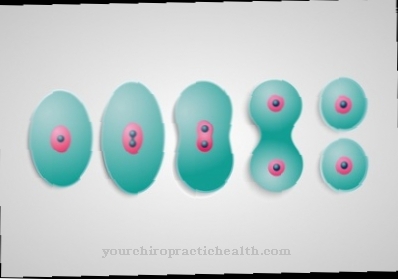The habitual occlusion corresponds to the habitually adopted tooth locking position, which usually takes place with maximum contact. If the bite is missed, the habitual occlusion does not correspond to the physiologically intended occlusion. The so-called occlusion line helps to objectify bite misalignments.
What is habitual occlusion?

In dentistry, the occlusion corresponds to the closure of the teeth. This is the position that the lower to the upper row of teeth assumes when the jaw closes freely in the final bite position.
The two main types of occlusion are static and dynamic occlusion. In the static form of the occlusion, the lower and upper rows of teeth are united to maximum possible multi-point contact and without movement of the lower jaw. The habitual occlusion is a sub-form of this type of occlusion. More precisely, it is a habitually assumed union of teeth with maximum intercuspation. The cusps and dimples in the upper and lower jaw completely interlock.
The contact points of an occlusion are on the so-called occlusal plane. This plane is curved or twisted sagittally and transversely instead of planar. The medical terms the Spee and Wilson curve describe this curvature.
Function & task
When the mouth is closed, the teeth of the lower jaw automatically come into contact with the tooth strips of the upper jaw. At which points there is contact between the lower and upper teeth depends on the individual case.
The habitual occlusion comprises the tooth contacts that arise between the upper jaw and the lower jaw when the patient bites habitually. Habitual occlusion is assumed relatively unconsciously and its tooth contacts cannot be changed via conscious processes. Usually the habitual occlusion corresponds to the intercuspation position and thus the bite to maximum contact between the rows of teeth.
A wrong bite is a habitually incorrect occlusion. The occlusal plane or masticatory plane corresponds to the spatial plane on which the rows of teeth of the lower and upper jaw meet. It is constructed via the connecting lines between the cutting edge contact point of teeth 31 and 41 and the distal cusp of teeth 36 and 46.
With a healthy habitual occlusion, the occlusal plane runs through the lip closure line and is thus approximately parallel to the connecting line of the two pupils and parallel to the Camper's plane.
For a habitually healthy occlusion, orthodontics defines an occlusal plane as the connecting line between two constructed points. The point vPOcP is defined by halving the intermediate distance at the incisor overbite and thus corresponds to the midpoint on the connecting line between the contact points of the lower upper central incisors. In this scheme, the hPOcP corresponds as the second constructed point to the dital contact point of the molars in occlusion.
The occlusal plane enables an orientation for angulations of the lower and upper teeth and makes the angular position of the occlusal plane to different reference points possible. If the habitual occlusion deviates too far from the healthy occlusal plane, there is a malocclusion. Angulations and malfunctions of the rows of teeth can be objectified thanks to this level.
The occlusal plane is the rough mean value from the clinical occlusion curve. This Spee’s curve corresponds to the natural course of the occlusal planes of individual teeth. The level of habitual occlusion usually does not correspond to the ideal level.
You can find your medication here
➔ Toothache medicationIllnesses & ailments
In the case of dysgnathia, the habitual occlusion differs more or less strongly from the natural occlusal plane. These findings are non-physiological developments of the lower or upper jaw, which can lead to a shift in the individual rows of teeth.
In addition to pro and retro genius, pro and retrognathy are also dysgnathias. Mandibular prognathy and mandibular retrognathy are characteristic examples of such malocclusions. The mandibular prognathy is genetic. The chin and lower lip protrude from this bite and a positive lip step is formed. In habitual occlusion, the front teeth in the lower jaw are located in front of the front teeth in the upper jaw. This can result in damage to the affected teeth and damage to the periodontium. Premature tooth loss is conceivable as a long-term consequence.
In mandibular retrognathia, which is also genetically determined, there is a protruding upper lip in addition to a receding chin. This creates a negative lip step. The front teeth on the upper jaw step in front of the front teeth of the lower jaw during occlusion. Often the lower jaw also bites into the palate. With this type of malocclusion, too, damage to the teeth or damage to the tooth supporting structure can occur, which in the long term can lead to premature tooth loss.
Often, dentition abnormalities are assessed on the basis of the habitual occlusion of the first lower molar to the first upper molar. This assessment is based on the Angle classification. Findings correspond to either Angle Class I, II1, II2 or III. In Angle Class I, the anterior cusp of the upper six-year molar grips between the cusps of the lower six-year molar. This occlusion position corresponds to the so-called neutral occlusion. Angle class II1 results are found if the anterior cusp of the six-year upper molar is occluded in front of the anterior cusp of the six-year lower molar and the upper front teeth are protruded. This habitual occlusion mainly results from long thumb sucking during childhood.
In Angle class II2 findings, the anterior cusp of the six-year upper molar occludes in front of the anterior cusp of the six-year lower molar and the upper anterior teeth are tilted towards the palate. Angle class III is when the anterior cusp of the six-year upper molar occludes behind the second cusp of the six-year lower molar.












.jpg)



.jpg)










.jpg)
